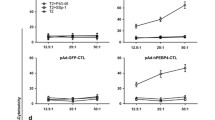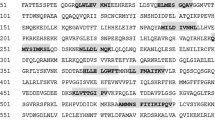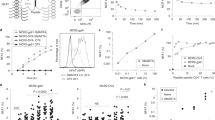Abstract
Nectin-4 is a tumor antigen present on the surface of breast, ovarian and lung carcinoma cells. It is rarely present in normal adult tissues and is therefore a candidate target for cancer immunotherapy. Here, we identified a Nectin-4 antigenic peptide that is naturally presented to T cells by HLA-A2 molecules. We first screened the 502 nonamer peptides of Nectin-4 (510 amino acids) for binding to and off-rate from eight different HLA class I molecules. We then combined biochemical, cellular and algorithmic assays to select 5 Nectin-4 peptides that bound to HLA-A*02:01 molecules. Cytolytic T lymphocytes were obtained from healthy donors, that specifically lyzed HLA-A2+ cells pulsed with 2 out of the 5 peptides, indicating the presence of anti-Nectin-4 CD8+ T lymphocytes in the human T cell repertoire. Finally, an HLA-A2-restricted cytolytic T cell clone derived from a breast cancer patient recognized peptide Nectin-4145–153 (VLVPPLPSL) and lyzed HLA-A2+ Nectin-4+ breast carcinoma cells. These results indicate that peptide Nectin-4145–153 is naturally processed for recognition by T cells on HLA-A2 molecules. It could be used to monitor antitumor T cell responses or to immunize breast cancer patients.




Similar content being viewed by others
Abbreviations
- CTL:
-
Cytolytic T lymphocyte
- EBV:
-
Epstein–Barr virus
- EBV-B:
-
B cells transformed by the Epstein–Barr virus
- ERBB2:
-
Erb-B2 receptor tyrosine kinase 2
- GnT-V:
-
N-acetylglucosaminyltransferase V
- HER2:
-
Human epidermal growth factor receptor 2
- MAGEA3:
-
Melanoma antigen family A3
- MAGEA10:
-
Melanoma antigen family A10
- MAGEC2:
-
Melanoma antigen family C2
- MFI:
-
Mean fluorescence intensity
- MUC1:
-
Mucin 1
- NY-ESO-1:
-
New York esophageal squamous cell carcinoma 1
- PRAME:
-
Preferentially expressed antigen in melanoma
- PVRL4:
-
Poliovirus receptor-related 4
- TAP:
-
Transporter associated with antigen processing
References
Sliwkowski MX, Mellman I (2013) Antibody therapeutics in cancer. Science 341(6151):1192–1198
Coulie PG, Van den Eynde BJ, van der Bruggen P, Boon T (2014) Tumour antigens recognized by T lymphocytes: at the core of cancer immunotherapy. Nat Rev Cancer 14(2):135–146
Fabre-Lafay S, Monville F, Garrido-Urbani S, Berruyer-Pouyet C, Ginestier C, Reymond N, Finetti P, Sauvan R, Adelaide J, Geneix J, Lecocq E, Popovici C, Dubreuil P, Viens P, Goncalves A, Charafe-Jauffret E, Jacquemier J, Birnbaum D, Lopez M (2007) Nectin-4 is a new histological and serological tumor associated marker for breast cancer. BMC Cancer 7:73
Reymond N, Fabre S, Lecocq E, Adelaide J, Dubreuil P, Lopez M (2001) Nectin4/PRR4, a new afadin-associated member of the nectin family that trans-interacts with nectin1/PRR1 through V domain interaction. J Biol Chem 276(46):43205–43215
Fabre-Lafay S, Garrido-Urbani S, Reymond N, Goncalves A, Dubreuil P, Lopez M (2005) Nectin-4, a new serological breast cancer marker, is a substrate for tumor necrosis factor-alpha-converting enzyme (TACE)/ADAM-17. J Biol Chem 280(20):19543–19550
Takai Y, Ikeda W, Ogita H, Rikitake Y (2008) The immunoglobulin-like cell adhesion molecule nectin and its associated protein afadin. Annu Rev Cell Dev Biol 24:309–342
Takai Y, Nakanishi H (2003) Nectin and afadin: novel organizers of intercellular junctions. J Cell Sci 116(Pt 1):17–27
Reymond N, Imbert AM, Devilard E, Fabre S, Chabannon C, Xerri L, Farnarier C, Cantoni C, Bottino C, Moretta A, Dubreuil P, Lopez M (2004) DNAM-1 and PVR regulate monocyte migration through endothelial junctions. J Exp Med 199(10):1331–1341
Takai Y, Miyoshi J, Ikeda W, Ogita H (2008) Nectins and nectin-like molecules: roles in contact inhibition of cell movement and proliferation. Nat Rev Mol Cell Biol 9(8):603–615
Pende D, Bottino C, Castriconi R, Cantoni C, Marcenaro S, Rivera P, Spaggiari GM, Dondero A, Carnemolla B, Reymond N, Mingari MC, Lopez M, Moretta L, Moretta A (2005) PVR (CD155) and Nectin-2 (CD112) as ligands of the human DNAM-1 (CD226) activating receptor: involvement in tumor cell lysis. Mol Immunol 42(4):463–469
Kuramochi M, Fukuhara H, Nobukuni T, Kanbe T, Maruyama T, Ghosh HP, Pletcher M, Isomura M, Onizuka M, Kitamura T, Sekiya T, Reeves RH, Murakami Y (2001) TSLC1 is a tumor-suppressor gene in human non-small-cell lung cancer. Nat Genet 27(4):427–430
Brancati F, Fortugno P, Bottillo I, Lopez M, Josselin E, Boudghene-Stambouli O, Agolini E, Bernardini L, Bellacchio E, Iannicelli M, Rossi A, Dib-Lachachi A, Stuppia L, Palka G, Mundlos S, Stricker S, Kornak U, Zambruno G, Dallapiccola B (2010) Mutations in PVRL4, encoding cell adhesion molecule nectin-4, cause ectodermal dysplasia-syndactyly syndrome. Am J Hum Genet 87(2):265–273
Muhlebach MD, Mateo M, Sinn PL, Prufer S, Uhlig KM, Leonard VH, Navaratnarajah CK, Frenzke M, Wong XX, Sawatsky B, Ramachandran S, McCray PB Jr, Cichutek K, von Messling V, Lopez M, Cattaneo R (2011) Adherens junction protein nectin-4 is the epithelial receptor for measles virus. Nature 480(7378):530–533
Campadelli-Fiume G, Cocchi F, Menotti L, Lopez M (2000) The novel receptors that mediate the entry of herpes simplex viruses and animal alphaherpesviruses into cells. Rev Med Virol 10(5):305–319
Derycke MS, Pambuccian SE, Gilks CB, Kalloger SE, Ghidouche A, Lopez M, Bliss RL, Geller MA, Argenta PA, Harrington KM, Skubitz AP (2010) Nectin 4 overexpression in ovarian cancer tissues and serum: potential role as a serum biomarker. Am J Clin Pathol 134(5):835–845
Takano A, Ishikawa N, Nishino R, Masuda K, Yasui W, Inai K, Nishimura H, Ito H, Nakayama H, Miyagi Y, Tsuchiya E, Kohno N, Nakamura Y, Daigo Y (2009) Identification of nectin-4 oncoprotein as a diagnostic and therapeutic target for lung cancer. Cancer Res 69(16):6694–6703
Fabre S, Reymond N, Cocchi F, Menotti L, Dubreuil P, Campadelli-Fiume G, Lopez M (2002) Prominent role of the Ig-like V domain in trans-interactions of nectins. Nectin3 and nectin 4 bind to the predicted C-C’-C”-D beta-strands of the nectin1 V domain. J Biol Chem 277(30):27006–27013
Guilloux Y, Lucas S, Brichard VG, Van Pel A, Viret C, De Plaen E, Brasseur F, Lethé B, Jotereau F, Boon T (1996) A peptide recognized by human cytolytic T lymphocytes on HLA-A2 melanomas is encoded by an intron sequence of the N-acetylglucosaminyltransferase V gene. J Exp Med 183(3):1173–1183
Kawashima I, Hudson S, Tsai V, Southwood S, Takesako K, Appella E, Sette A, Celis E (1998) The multi-epitope approach for immunotherapy for cancer: identification of several CTL epitopes from various tumor-associated antigens expressed on solid epithelial tumors. Hum Immunol 59:1–14
Huang L-Q, Brasseur F, Serrano A, De Plaen E, van der Bruggen P, Boon T, Van Pel A (1999) Cytolytic T lymphocytes recognize an antigen encoded by MAGE-A10 on a human melanoma. J Immunol 162:6849–6854
Ma W, Germeau C, Vigneron N, Maernoudt A-S, Morel S, Boon T, Coulie PG, Van den Eynde B (2004) Two new tumor-specific antigenic peptides encoded by gene MAGE-C2 and presented to cytolytic T lymphocytes by HLA-A2. Int J Cancer 109:698–702
Ma W, Vigneron N, Chapiro J, Stroobant V, Germeau C, Boon T, Coulie PG, Van den Eynde BJ (2011) A MAGE-C2 antigenic peptide processed by the immunoproteasome is recognized by cytolytic T cells isolated from a melanoma patient after successful immunotherapy. Int J Cancer 129:2427–2434
Rimoldi D, Rubio-Godoy V, Dutoit V, Liénard D, Salvi S, Guillaume P, Speiser D, Stockert E, Spagnoli G, Servis C, Cerottini J-C, Lejeune F, Romero P, Valmori D (2000) Efficient simultaneous presentation of NY-ESO-1/LAGE-1 primary and nonprimary open reading frame-derived CTL epitopes in melanoma. J Immunol 165:7253–7261
Ikeda H, Lethé B, Lehmann F, Van Baren N, Baurain J-F, De Smet C, Chambost H, Vitale M, Moretta A, Boon T, Coulie PG (1997) Characterization of an antigen that is recognized on a melanoma showing partial HLA loss by CTL expressing an NK inhibitory receptor. Immunity 6(2):199–208
Molldrem JJ, Clave E, Jiang YZ, Mavroudis D, Raptis A, Hensel N, Agarwala V, Barrett AJ (1997) Cytotoxic T lymphocytes specific for a nonpolymorphic proteinase 3 peptide preferentially inhibit chronic myeloid leukemia colony-forming units. Blood 90(7):2529–2534
Wölfel T, Van Pel A, Brichard V, Schneider J, Seliger B, Meyer zum Büschenfelde K-H, Boon T (1994) Two tyrosinase nonapeptides recognized on HLA-A2 melanomas by autologous cytolytic T lymphocytes. Eur J Immunol 24:759–764
Doytchinova IA, Walshe VA, Jones NA, Gloster SE, Borrow P, Flower DR (2004) Coupling in silico and in vitro analysis of peptide-MHC binding: a bioinformatic approach enabling prediction of superbinding peptides and anchorless epitopes. J Immunol 172(12):7495–7502
Nijman HW, Houbiers JG, Vierboom MP, van der Burg SH, Drijfhout JW, D’Amaro J, Kenemans P, Melief CJ, Kast WM (1993) Identification of peptide sequences that potentially trigger HLA-A2.1-restricted cytotoxic T lymphocytes. Eur J Immunol 23(6):1215–1219
Serody JS, Collins EJ, Tisch RM, Kuhns JJ, Frelinger JA (2000) T cell activity after dendritic cell vaccination is dependent on both the type of antigen and the mode of delivery. J Immunol 164(9):4961–4967
Strous GJ, van Kerkhof P, van Meer G, Rijnboutt S, Stoorvogel W (1993) Differential effects of brefeldin A on transport of secretory and lysosomal proteins. J Biol Chem 268(4):2341–2347
DiBrino M, Tsuchida T, Turner RV, Parker KC, Coligan JE, Biddison WE (1993) HLA-A1 and HLA-A3 T cell epitopes derived from influenza virus proteins predicted from peptide binding motifs. J Immunol 151(11):5930–5935
Baurain J-F, Colau D, van Baren N, Landry C, Martelange V, Vikkula M, Boon T, Coulie PG (2000) High frequency of autologous anti-melanoma CTLs directed against an antigen generated by a point mutation in a new helicase gene. J Immunol 164:6057–6066
Garboczi DN, Hung DT, Wiley DC (1992) HLA-A2-peptide complexes: refolding and crystallization of molecules expressed in Escherichia coli and complexed with single antigenic peptides. Proc Natl Acad Sci USA 89(8):3429–3433
Boccaccio C, Jacod S, Kaiser A, Boyer A, Abastado JP, Nardin A (2002) Identification of a clinical-grade maturation factor for dendritic cells. J Immunother 25(1):88–96
Ottaviani S, Zhang Y, Boon T, van der Bruggen P (2005) A MAGE-1 antigenic peptide recognized by human cytolytic T lymphocytes on HLA-A2 tumor cells. Cancer Immunol Immunother 54:1214–1220
Karanikas V, Lurquin C, Colau D, van Baren N, De Smet C, Lethé B, Connerotte T, Corbière V, Demoitié M-A, Liénard D, Dréno B, Velu T, Boon T, Coulie PG (2003) Monoclonal anti-MAGE-3 CTL responses in melanoma patients displaying tumor regression after vaccination with a recombinant canarypox virus. J Immunol 171(9):4898–4904
Godelaine D, Carrasco J, Lucas S, Karanikas V, Schuler-Thurner B, Coulie PG, Schuler G, Boon T, Van Pel A (2003) Polyclonal CTL responses observed in melanoma patients vaccinated with dendritic cells pulsed with a MAGE-3.A1 peptide. J Immunol 171(9):4893–4897
Bachinsky MM, Guillen DE, Patel SR, Singleton J, Chen C, Soltis DA, Tussey LG (2005) Mapping and binding analysis of peptides derived from the tumor-associated antigen survivin for eight HLA alleles. Cancer Immun 5:6
Shingler WH, Chikoti P, Kingsman SM, Harrop R (2008) Identification and functional validation of MHC class I epitopes in the tumor-associated antigen 5T4. Int Immunol 20(8):1057–1066
Thome JJ, Yudanin N, Ohmura Y, Kubota M, Grinshpun B, Sathaliyawala T, Kato T, Lerner H, Shen Y, Farber DL (2014) Spatial map of human T cell compartmentalization and maintenance over decades of life. Cell 159(4):814–828
Parker KC, Bednarek MA, Coligan JE (1994) Scheme for ranking potential HLA-A2 binding peptides based on independent binding of individual peptide side-chains. J Immunol 152(1):163–175
Vigneron N, Stroobant V, Van den Eynde BJ, van der Bruggen P (2013) Database of T cell-defined human tumor antigens: the 2013 update. Cancer Immun 13:15
Acknowledgments
This work was supported by grants from INSERM, Institut Paoli-Calmettes, Ligue Nationale Contre le Cancer, Institut National du Cancer (AO projet libre, 2008–2010), and Fondation contre le Cancer (Brussels, Belgium).
Author information
Authors and Affiliations
Corresponding author
Ethics declarations
Conflict of interest
The authors declare no conflict of interest.
Rights and permissions
About this article
Cite this article
Lopez, M., Ghidouche, A., Rochas, C. et al. Identification of a naturally processed HLA-A*02:01-restricted CTL epitope from the human tumor-associated antigen Nectin-4. Cancer Immunol Immunother 65, 1177–1188 (2016). https://doi.org/10.1007/s00262-016-1877-7
Received:
Accepted:
Published:
Issue Date:
DOI: https://doi.org/10.1007/s00262-016-1877-7




